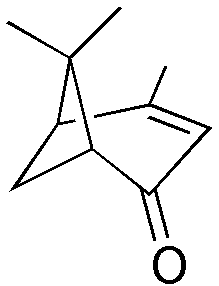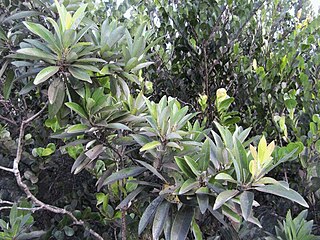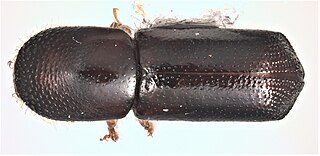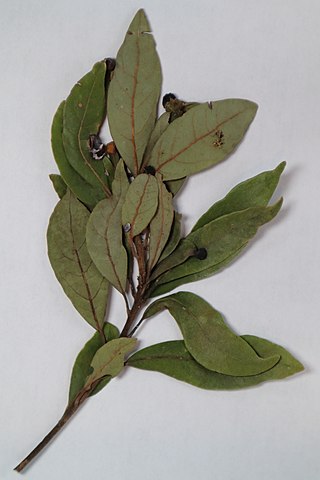Ambrosia beetles are beetles of the weevil subfamilies Scolytinae and Platypodinae, which live in nutritional symbiosis with ambrosia fungi. The beetles excavate tunnels in dead or stressed trees in which they cultivate fungal gardens, their sole source of nutrition. After landing on a suitable tree, an ambrosia beetle excavates a tunnel in which it releases its fungal symbiont. The fungus penetrates the plant's xylem tissue, extracts nutrients from it, and concentrates the nutrients on and near the surface of the beetle gallery. Ambrosia fungi are typically poor wood degraders, and instead utilize less demanding nutrients. Symbiotic fungi produce and detoxify ethanol, which is an attractant for ambrosia beetles and likely prevents growth of antagonistic pathogens and selects for other beneficial symbionts. The majority of ambrosia beetles colonize xylem of recently dead trees, but some attack stressed trees that are still alive, and a few species attack healthy trees. Species differ in their preference for different parts of trees, different stages of deterioration, and in the shape of their tunnels ("galleries"). However, the majority of ambrosia beetles are not specialized to any taxonomic group of hosts, unlike most phytophagous organisms including the closely related bark beetles. One species of ambrosia beetle, Austroplatypus incompertus exhibits eusociality, one of the few organisms outside of Hymenoptera and Isoptera to do so.

A bark beetle is the common name for the subfamily of beetles Scolytinae. Previously, this was considered a distinct family (Scolytidae), but is now understood to be a specialized clade of the "true weevil" family (Curculionidae). Although the term "bark beetle" refers to the fact that many species feed in the inner bark (phloem) layer of trees, the subfamily also has many species with other lifestyles, including some that bore into wood, feed in fruit and seeds, or tunnel into herbaceous plants. Well-known species are members of the type genus Scolytus, namely the European elm bark beetle S. multistriatus and the large elm bark beetle S. scolytus, which like the American elm bark beetle Hylurgopinus rufipes, transmit Dutch elm disease fungi (Ophiostoma). The mountain pine beetle Dendroctonus ponderosae, southern pine beetle Dendroctonus frontalis, and their near relatives are major pests of conifer forests in North America. A similarly aggressive species in Europe is the spruce ips Ips typographus. A tiny bark beetle, the coffee berry borer, Hypothenemus hampei is a major pest on coffee plantations around the world.

Oak wilt is a fungal disease caused by the organism Bretziella fagacearum that threatens Quercus spp. The disease is limited to the eastern half of the United States; first described in the 1940s in the Upper Mississippi River Valley. The pathogen penetrates xylem tissue, preventing water transport and causing disease symptoms. Symptoms generally consist of leaf discoloration, wilt, defoliation, and death. The disease is dispersed by insect vectors and to adjacent trees through underground root networks. However, human spread is the most consequential dispersal method. Moving firewood long distances can potentially transport diseases and invasive species.

Verbenone is a natural organic compound classified as a terpene that is found naturally in a variety of plants. The chemical has a pleasant characteristic odor. Besides being a natural constituent of plants, it and its analogs are insect pheromones. In particular, verbenone when formulated in a long-lasting matrix has an important role in the control of bark beetles such as the mountain pine beetle and the Southern pine bark beetle.

Sassafras albidum is a species of Sassafras native to eastern North America, from southern Maine and southern Ontario west to Iowa, and south to central Florida and eastern Texas. It occurs throughout the eastern deciduous forest habitat type, at altitudes of up to 1,500 m (4,900 ft) above sea level. It formerly also occurred in southern Wisconsin, but is extirpated there as a native tree.

Persea palustris, also known as swamp bay or swampbay, is a small tree or shrub found throughout the Southeastern United States and the Bahamas, with much of its range overlapping with that of its relative Persea borbonia. It is generally not more than 40 feet tall, with bark separated into scales by fissures across its surface. Mature leaves are green, paler on their undersides, which have prominent brownish or reddish-brown hairs. The species prefers swamps and coastal areas, particularly locations with moist, peat-rich soil. It is sensitive to the fungal disease known as laurel wilt, even more so than related species.

Xyleborus glabratus, the redbay ambrosia beetle, is a type of ambrosia beetle invasive in the United States. It has been documented as the primary vector of Raffaelea lauricola, the fungus that causes laurel wilt, a disease that can kill several North American tree species in the family Lauraceae, including redbay, sassafras, and avocado.

Lindera melissifolia, common name pondberry or southern spicebush, is a stoloniferous, deciduous, aromatic shrub in the laurel family. This endangered species is native to the southeastern United States, and its demise is associated with habitat loss from extensive drainage of wetlands for agriculture and forestry. Restoration efforts are currently being conducted.

Persea borbonia or redbay is a small, evergreen tree in the laurel family (Lauraceae), native to the southeastern United States. It belongs to the genus Persea, a group of evergreen trees including bays and the avocado. Persea borbonia has several common names including tisswood, scrubbay, shorebay, and swampbay.
Ambrosiella is a genus of ambrosia fungi within the family Ceratocystidaceae. It was circumscribed by mycologists Josef Adolph von Arx and Grégoire L. Hennebert in 1965 with Ambrosiella xylebori designated as the type species. All Ambrosiella species are obligate symbionts of ambrosia beetles. Several former species were moved to genera Raffaelea, Hyalorhinocladiella, or Phialophoropsis, and there were nine species recognized 2017. Twelve species in as of 2023. One species, Ambrosiella cleistominuta, has been observed to produce a fertile sexual state with cleistothecious ascomata.
Raffaelea quercivora is a species of fungus in the family Ophiostomataceae. It causes Japanese oak wilt disease, and is spread by the ambrosia beetle. It has small obovoid to pyriform sympodioconidia and slender, long conidiophores. The fungus has been isolated from the body surfaces and mycangia of the beetle.
Japanese oak wilt is a fungal disease caused by Raffaelea quercivora fungus affecting by oak trees. In 1998, Japanese plant pathologists group was isolation, inoculation and reisolation the dead tree. It is the first disease known that Raffaela fungus cause plant disease.
Raffaelea subfusca is a mycangial fungus, first isolated from female adults of the redbay ambrosia beetle, Xyleborus glabratus.
Raffaelea fusca is a mycangial fungus, first isolated from female adults of the redbay ambrosia beetle, Xyleborus glabratus.
Raffaelea ellipticospora is a mycangial fungus, first isolated from female adults of the redbay ambrosia beetle, Xyleborus glabratus.
Raffaelea subalba is a mycangial fungus, first isolated from female adults of the redbay ambrosia beetle, Xyleborus glabratus.

Raffaelea is a genus of ambrosia fungi in the family Ophiostomataceae. It was circumscribed by mycologists Josef Adolph von Arx and Grégoire L. Hennebert in 1965 with Raffaelea ambrosiae as the type species. The genus is named in honor of Italian botanist Raffaele Ciferri.

Euwallacea fornicatus is a species complex consisting of multiple cryptic species of ambrosia beetles, known as an invasive species in California, Israel and South Africa. The species has also been unintentionally introduced into exotic greenhouses in several European countries. As the rest of the ambrosia beetles, E. fornicatus larvae and adults feed on a symbiotic fungus carried in a specific structure called mycangium. In E. fornicatus, the mycangium is located in the mandible. The combination of massive numbers of beetles with the symbiotic fungus kills trees, even though the fungus alone is a weak pathogen.
Platypus quercivorus, the oak ambrosia beetle, is a species of weevil and pest of broad-leaved trees. This species is most commonly known for vectoring the fungus responsible for excessive oak dieback in Japan since the 1980s. It is found in Japan, India, Indonesia, New Guinea, and Taiwan.










